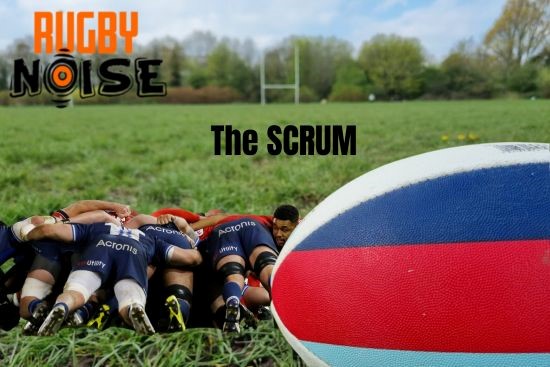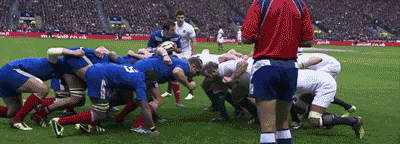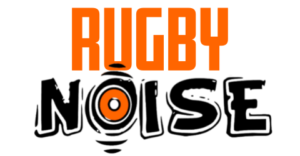The set piece is a huge part of Rugby and in many ways defines its look as a sport. Despite that, not a lot of fans really know how the scrum works. Seeing as it is so complicated, let’s take a look at how the scrum works in rugby.
How does a rugby scrum work? The scrum is when eight forwards from both teams attempt to push each other back, while the Scrum-Half feeds the ball into the middle of the scrum.

The scrum as a concept is actually pretty complicated when you think about it. A scrum occurs for a few different reasons. The main cause of a scrum is that when the ball is knocked on by one team, a scrum is awarded to the other team. A scrum is also awarded if there is a forward pass.
Teams can choose to have a scrum if they win a penalty or a free kick as well. When a scrum is called, the eight forwards must get into the right formation. The three front row players are at the front, with the second row just behind. The flankers are on the sides of the scrum, with the number eight right at the back.
There are not always eight players in a scrum each time as when there are cards, teams will sometimes scrummage with just seven players instead of eight. This usually gives the team with the man advantage a significant power advantage in the scrum.
The players in the scrum interlink with each other so that the players can produce as much power as possible. The two front rows push with their shoulders against the shoulders of the opposition. When the scrum is set, the scrum half will roll the ball into the scrum. When the ball is in, the team’s can start to try pushing each other backwards.
The scrum half will usually roll the ball slightly towards their team. Once the ball is in the scrum, the hookers are supposed to hook the ball backwards with their foot to bring it to their team. The ball is supposed to come out of the scrum by the number eight feet. Once the ball is out of the scrum, the scrum is over and the player’s can leave the scrum.
Possession of the ball can be stolen by the other team. This happens when the ball is hooked back by the opposition team, or the opposing team pushes the scrum forward and get the ball. While it might seem pretty simple, the infringements that happen at the scrum can make things complicated.

There are various different penalties which can be won at the scrum. Quite often, having a dominant scrum in a game gives that team a huge advantage as they can win possession and penalties from the scrum.
What are the penalties for at a scrum?
One of the most confusing things in rugby is when a penalty is given at the scrum. Due to the complexity of the set piece, it can be pretty difficult to determine why a penalty has been given.
Penalties are awarded against the scrummaging team that collapses the scrum, starts pushing too early, pushes sideways instead of forwards and pops up from the scrum first. While that sounds complicated, it is actually a lot easier to understand than you might think.
The primary reason for a penalty being given out at the scrum is because one team collapsed the scrum. When one team has a dominant scrum, the opposition will usually collapse onto the floor because they are not able to move backwards without falling over.
It is illegal to collapse the scrum and a penalty will be awarded against the team that does this. It is not always easy to determine which team collapses the scrum, particularly when it does not move in either direction. Usually the team that goes to ground first will be penalised.
However, if one of the forwards is purposefully hinging at the hips and not pushing forward, they will be the one who has the penalty called against them. Similarly, a scrum can become a bit of a mess when players start standing up because the pushing is going upwards.
In this case, it is usually the first player who stands up or pops their head out of the scrum which will be penalised. There can also be penalties given for players driving incorrectly. If the referee decides that one team is driving around the other instead of through, then a penalty can be awarded.
Some minor infringements can also be upgraded to a penalty. There are some offences which are usually a free kick, but if one team does them multiple times then the referee will instead award a penalty.
Things like taking too long to form the scrum or engaging too early are usually free kicks. But they will be upgraded to a penalty if one team does it twice in a row.
Does the ball have to go in straight in a scrum?
Putting the ball into the scrum is the job of the scrum half. It is a very important job, as both teams are looking to hold onto possession during the scrum.
The ball must be put straight into the scrum. However, the scrum half can align their shoulder with the middle of the scrum. This means they can turn their shoulders slightly towards their team and put the ball in slightly towards their own team.
This rule is one that is very often abused in professional rugby. The issue is referees do not often give a penalty the other way if the scrum half does not put the ball straight into the scrum.
It means that the scrum is not always competitive. When the ball is being rolled into the scrum closer to one side, it takes away from the contest part of the scrum. It makes it pointless for the scrum to take place if one team is guaranteed to win the scrum.
So you can see why the rule is quite important in rugby and should be enforced more.
